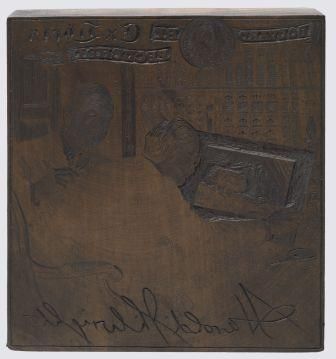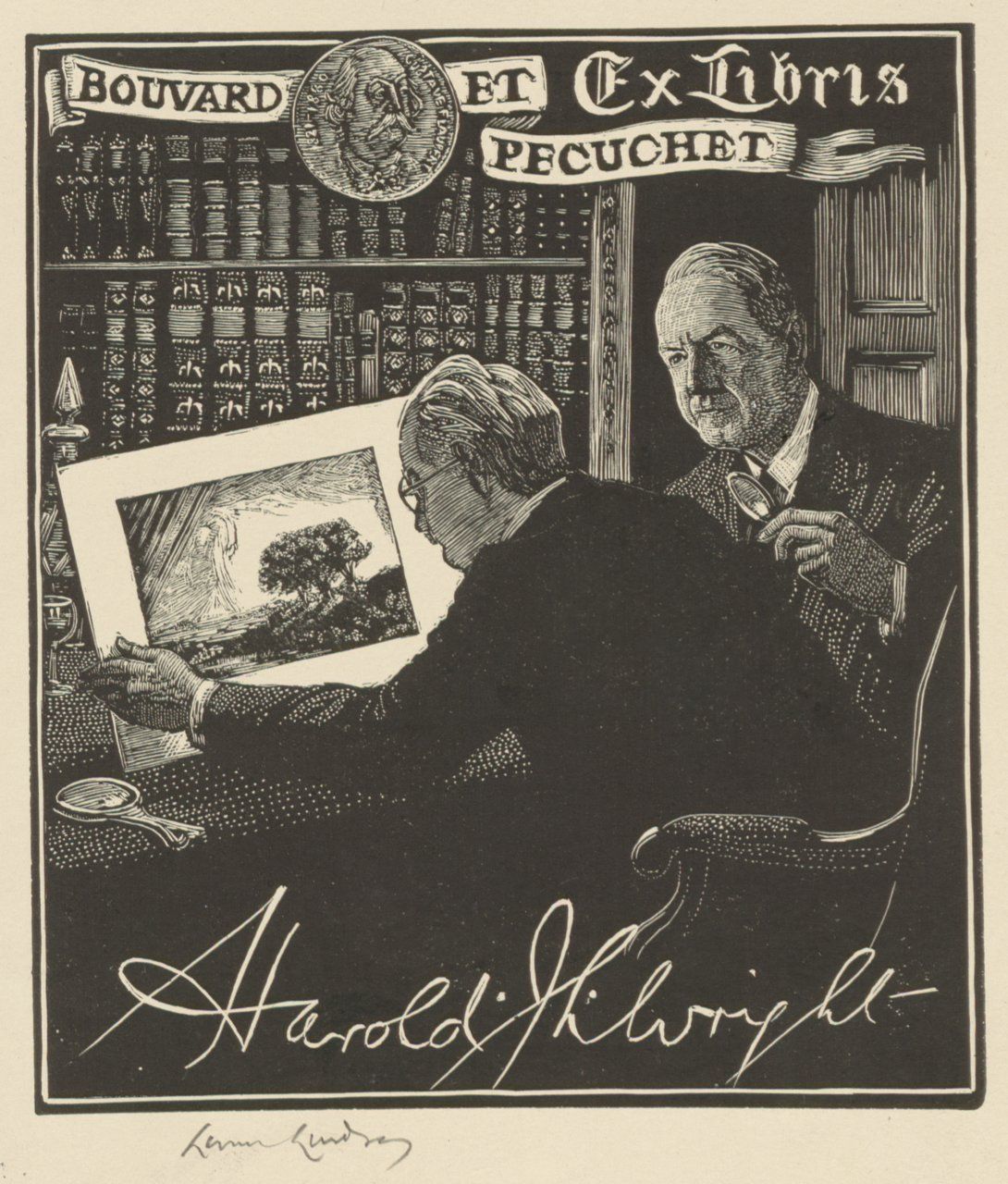Bookplate for Harold J. Wright by Lionel Lindsay
Download

Bookplate for Harold J. Wright, 1944
printing block for wood engraving
wood
10.1 × 9.0 × 2.3 cm (block)
Bequest of Mrs L.I. Wright, 1964
Baillieu Library Print Collection
University of Melbourne
1964.2684
©Lionel Lindsay
Baillieu Library Print Collection, University of Melbourne
We are accustomed to seeing prints in their final state. But the wooden block for Harold Wright’s bookplate or Ex libris (‘From the library of’) shows a wood engraving in its original, smoky, reversed incarnation. This provides a unique glimpse at just how much foresight, imagination and mental transposition the engraver must possess in order to craft a block that will realise their vision in the finished print.
Beyond its function as a nameplate to adorn books in the collection of Harold Wright (British print dealer and philanthropist, 1885–1961), this bookplate is also a portrait of the friendship between Wright and Lindsay as they scrutinise the patron’s newly acquired etching, Three trees by Rembrandt. The inscription to ‘Bouvard et Pecuchet’, characters from a novel by Flaubert, is another symbol of their friendship and mutual interests. Around them the walls are stacked with ornately bound books, and a wine glass and decanter (discernible only upon close examination) – a celebration of fine things of all kind.
Lindsay sets the scene with an undisclosed central light source (it appears to come from the print itself!), taking advantage of his adeptness for making wood engravings, which usually have a largely black negative space. In the finished image, the faces, furniture and book spines, formed by a network of delicate white lines, emerge out of the darkness.
Teaching ideas
The University of Melbourne’s curriculum is rich and varied, and changes from year to year. For more teaching ideas, contact a collection manager.
The Print Room
Wood engraving was among Lionel Lindsay’s favourite techniques. On Harold Wright’s bookplate, the grain of the wood is visible upon close inspection, indicating that it is the end-grain of the piece of wood. Consider the differences in process and output between:
- a wood engraving and a woodcut (a woodcut uses the plank-side area of wood, which is much softer and easier to carve away)
- a wood engraving and a steel or copper engraving.
Introduction to Printmaking Processes
Visit the Print Collection – in the Baillieu Library and online – to gain knowledge and understanding of a range of methods and materials, in order to build your confidence in exploring and experimenting with a variety of printmaking processes.
Collection Management
Visit the Baillieu Library Print Room and look at Harold Wright’s collection of prints, bequeathed in 1964. Consider the opportunities and challenges of receiving a single-owner bequest of some 700+ objects.
Australian Art
Using the Baillieu Library Print Collection’s extensive holdings of works by Lionel Lindsay, consider his influence on Australian printmaking in the early to mid-20th century.
Art, Market and Methods
Use this image as a starting point to discuss the history and future of artist–collector relationships, from early modern artist–patron relationships through to 20th-century collaborations.
Exhibition Management
Looking at the Harold Wright bookplate block and print side by side, discuss ways in which the display of a work of art can be improved or diminished by pairing it with a relevant object. Consider the pros and cons of displaying a work alongside the tools used to create it.
Intersecting objects
-

Lionel Lindsay (Australian, 1874–1961)
Bookplate for Harold J. Wright, 1944
wood engraving
10.2 × 9.1 cm (image)
Bequest of Mrs L.I. Wright, 1964
Baillieu Library Print
Collection University of Melbourne
1964.2400
© Lionel Lindsay -

Rembrandt van Rijn (Dutch, 1606–1669)
Three trees, 1643
etching, drypoint
20.8 × 27.7 cm (sheet trimmed to image)
Gift of Dr J. Orde Poynton, 1959
Baillieu Library Print Collection
University of Melbourne
1959.3728
To learn more, visit the website of the Baillieu Library Print Collection.
References
Kim Clayton-Greene, ‘Yours faithfully: Harold Wright and Lionel Lindsay, a long friendship’, in Kerrianne Stone & Stephanie Jaehrling (eds), Print Matters at the Baillieu, Cussonia Press, University of Melbourne, 2011, pp. 37–9.
Further reading
Paul Goldman, Looking at prints: A guide to technical terms, London: British Museum, 1981.
Joanna Mendelssohn, The art of Sir Lionel Lindsay, Sydney: Copperfield Publishing, 1982–87.
Sue Scullard, Wood engraving and printing, video illustrating the wood engraving technique.